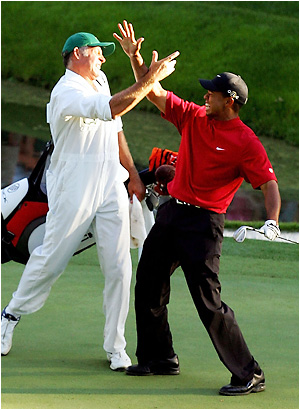I’m not sure why it popped into his head, but when we were at the Phillies game last week Haas told me I should do a post on the evolution of the high-five. It sounded like a pretty good idea, but I don’t think I’m really qualified. I’m no high-five expert. Sure, I could run down the basics. You’ve got your standard high-five, your homo-erotic Top Gun Five, the Bash Brothers elbow smash that ushered in the steroid era, then we progressed to knuckles, and of course there are the wildly elaborate high-five rituals that populate baseball dugouts and frat houses. There’s always little changes and barometers for what is cool and what isn’t. For example, when golfers started giving knuckles to each other? That was probably over.
Instead of talking evolution, I’m going to tweak it ever so slightly. I want to talk about the inherent youthfulness of the traditional high-five. There is something about it that just makes it more suitable for kids. Like mastering a video game controller in four seconds, kids are just wired to execute the high-five, or perhaps just more open the exuberance it takes to pull one off.
At some point in your life you stop giving high-fives. One day adults are coming up to you, mussing your hair and saying, “How about a high-five, buddy?” You are routinely giving high-fives to your friends for any manner of minor accomplishment. It’s almost second nature. You have fun giving them, but then you wake up one day and you are a little self-conscious about them. Is it still cool to high-five? Are people watching me? Should I be doing that knuckle thing? It may coincide when you notice members of the opposite sex. You can’t risk missing a high-five, or giving an inappropriate high-five in front of a girl. That’s pretty basic stuff.
The funny thing about straying from the high fives as you get older is that they most certainly are not like riding a bike. At the same Phillies game, Haas told me that if you look at the other person’s elbow, it is impossible to miss a high-five. I don’t think I’ve heard that before, but maybe I will try it the next time a big moment strikes. It’s an interesting theory, and obviously one an adult came up with. I don’t think the kid who just scored the winning run in T-ball is giving his buddy’s elbow the stare down. If he misses, c’est la vie, we just won 33-32, baby! Adults need little tricks like that, because they miss them, and look awful all the time. Note the picture above.
When a grown up gets into a true high-five moment, they’ve really returned to a childish level of glee. They are for a moment completely without that burdensome self-awareness. It’s a moment of pure celebration, but out of practice, it can usually go wrong. I think back to my historic field hockey goal, and I can say with some certainly that had I attempted a high-five in that instance, I probably would have missed it badly. I was euphoric, I forgot that maybe 100 people were watching me, and I launched into a full celebration. I was a kid again, willing to high-five, but it never materialized.
I don’t really know what my conclusion is. I don’t want to bring the high-five into everyday situations. It is special in some ways, and I think the knuckles and other variations can cheapen it some. I guess my point is, if you do find yourself in a moment where you are executing a high five (to whatever degree of success), you should take a moment to bask in your childlike wonder. The older you get, the harder it is to find.

